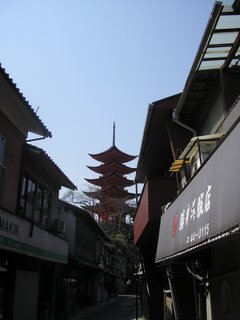

Afterwards, we checked out the torri gate again. It was high tide, so you could actually see it "floating" in the water.

We headed up to the top of Mt. Misen, which is directly behind the village. We had to take two trams, one small and one big and then climb up another 30-45 minutes to reach the very top. It was breathtakingly beautiful! We saw monkeys and more deer along the way and signs told us not to look at the monkeys directly or they will get aggressive and may attack. So, I was a bit nervous to look at them! They may be small, but I have great respect and they look pretty strong to me. They had light brown fur and bright red faces and bottoms. We didn't get any good pics of the monkeys.





Afterwards we went to Itsukushima Shrine - the floating temple. Just like the torii gate, it also sits in the water on pillars with long beautiful walkways and a view of the torii gate and ocean, a "floating stage" for Japanese performances and big beautiful lanterns. The story with the gate is that the island itself is/was considered a holy place, so commoners could not set foot on the island, boats had to first go through the torii gate in order to gain entry. The gate is part of Itsukushima Shrine.


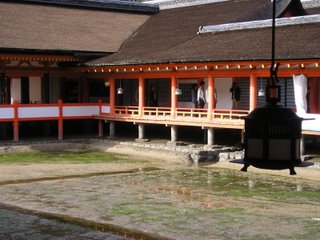

It was getting late in the day so we walked through the shrine quickly and then left Miyajima. Next stop was Naoshima, an island near Okayama that has two modern art museums and the "Art House Project". The last ferry to the island was at 9:45pm, we arrived at the port at 9:30pm so we had to run, but we went to the wrong boat, so we ran some more and yet again went to the wrong boat, more running and we arrived at the correct place and the little speed boat was ready to leave, so we hopped on and arrived in Naoshima 20 minutes later. We were lucky we caught the last boat.
We stayed in a dorm and met some Japanese women that were traveling on their own, so we took a really long walk together at night around the island. The next morning, we took the local bus to the various museums around the island. The story behind these museums being on a remote island is that a publishing company wanted to display their art collection and managed to get Ando to design the building. I don't really know much beyond that, because it seemed like a really small community. The northern part of the island has a car factory as well.
We went to Chichu Museum first, which was designed by the famous architect Ando Tadao. The museum fee was a bit high, but the building was really interesting. There are only five art pieces in the museum, a 3 panel Monet, a few installations by James Turell and an installation by Walter de Maria. The museum itself could be considered an art piece because I think the main idea was how the building space and the art interact and work together. It was a bit difficult to get a feel for it because there were many docents who were following us around and giving us directions, so it felt as if we did not get to spend time alone with the art or the building. The museum sits on the ocean and the building has interesting spaces and lines. We were not allowed to take pictures, but it was mostly concrete and glass and very modern. The small cafe at the museum faces the ocean, so we hung out and ate good food and took in the view.

Next stop was the "Art House Project" a plan to restore two- or three-hundred year old houses in the village and then into works of art. We visited 3 Art Houses, but there are 4 of them. One of them you have to make a reservation ahead of time and we were too late. One house is a collaboration by Ando and Turell. Ando designed the building at the site of a demolished old temple and used some of the material from the old temple in the building. Only 4-6 people can enter the building at a time. We were guided by the docents who had to lead us into a pitch-black room. We sat on benches and waited for our eyes to adjust. It takes about 10 minutes and then gradually you can see some light and Turell's installation. It actually made me really nauseous because I was straining so hard to see. This exhibit was at the DC Smithsonian a long time ago, but it was closed because someone had walked into the wall and broke their nose. Anyway, it was quite interesting, but I think the other people in our group enjoyed it more than me.
The next house we went to had pieces by Miyajima Tatsuo where he uses digital LCD clock number displays. The most beautiful was the installation in an old tatami room (straw mat room). They had removed the tatami mats and put water and the colorful numbers are at the bottom of the water. It's a beautiful piece of work in a beautiful setting.
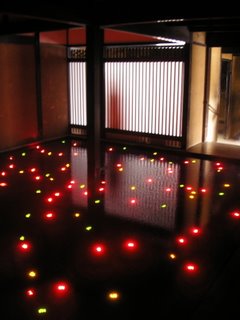
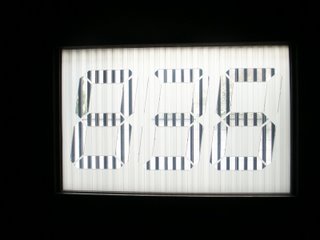
The final place we saw was at a shrine, which was renovated by installing a glass staircase. The glass staircase runs from the shrine, which sits high above the ground, into the ground and an underground chamber.

Finally, we went to The Benesse Museum, which was also designed by Ando. It is also made of concrete and glass, sits on the ocean and is very modern. The museum houses art by many famous western artists such as Andy Warhol, Jean Michel Basquiat, Jasper Johns, David Hockney, Jackson Pollack etc., but the art pieces themselves are not well known. I enjoyed this museum more than the other one. It had some interesting work and it just seemed less pretentious then the other museum. This museum has a lot of outdoor sculpture on and near the beach. The museum also has a hotel with art pieces in the hotel rooms and an outdoor hot tub overlooking the ocean and a monorail from the museum to the hotel. It might be nice to stay there if we ever go back again.



Naoshima is certainly worth a visit. We headed back to Himeji that evening.
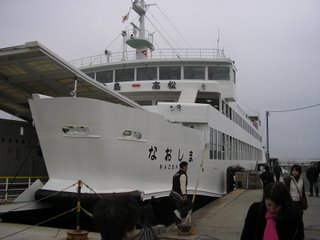
No comments:
Post a Comment